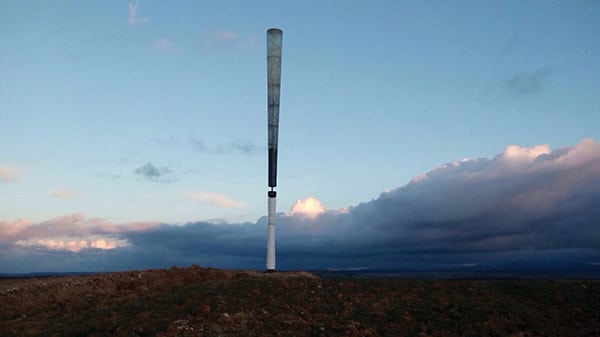New Approach Powers Bladeless Wind Turbine
An innovative wind turbine concept currently in the prototype phase captures the energy of vorticity, an aerodynamic effect also known as the “vortex shedding effect.”
As the wind bypasses a fixed structure, its flow changes and generates a cyclical pattern of vortices. Once these forces are strong enough, the fixed structure starts oscillating, may enter into resonance with the lateral forces of the wind, and can even collapse, said Spanish tech startup Vortex Bladeless, which is developing the turbine.
The concept got its start in 2002, when Vortex’s inventor and developer David Yáñez saw a video of the Tacoma Narrows Bridge swaying in the wind. In 1940, only three months after its inauguration, the state-of-the-art suspension bridge collapsed under the influence of vortex shedding, as well as fluttering and galloping effects.
The Vortex turbine design (Figure 4) completely eliminates mechanical elements that can suffer wear and tear from friction—which means it doesn’t need to replace mechanical parts or change oil and grease, translating into an estimated 80% reduction in maintenance costs, said the technology’s developers. It also saves 51% on operating costs and 53% on manufacturing costs.
“Of course, it won’t be immune to fatigue,” they added. “The wind can cause twisting and displacement of the structure, primarily in the elastic rod, especially in the lower section that has to withstand greater forces. However, studies carried out by the company confirm that, the stress on the rod is far from the working limit of the materials, that is, carbon fiber.”
According to computational modeling estimates, the operational lifetime of the installation is between 32 and 96 years, it said. Other attributes that could make it more attractive than conventional horizontal-axis wind turbines are that it is silent—it oscillates at a frequency of below 20 Hz—and because it has no rotating blades, it is safer for birds.
The company received a substantial grant in 2012 to develop a working prototype. Last year, Vortex started its first field test in Avila, Spain, and it said it is “very close” to finalizing a commercial pilot. It is also working on a number of small-scale wind turbine concepts from 100 W to 4 kW. It hopes to release a 1-MW device by 2018.
—Sonal Patel, associate editor
